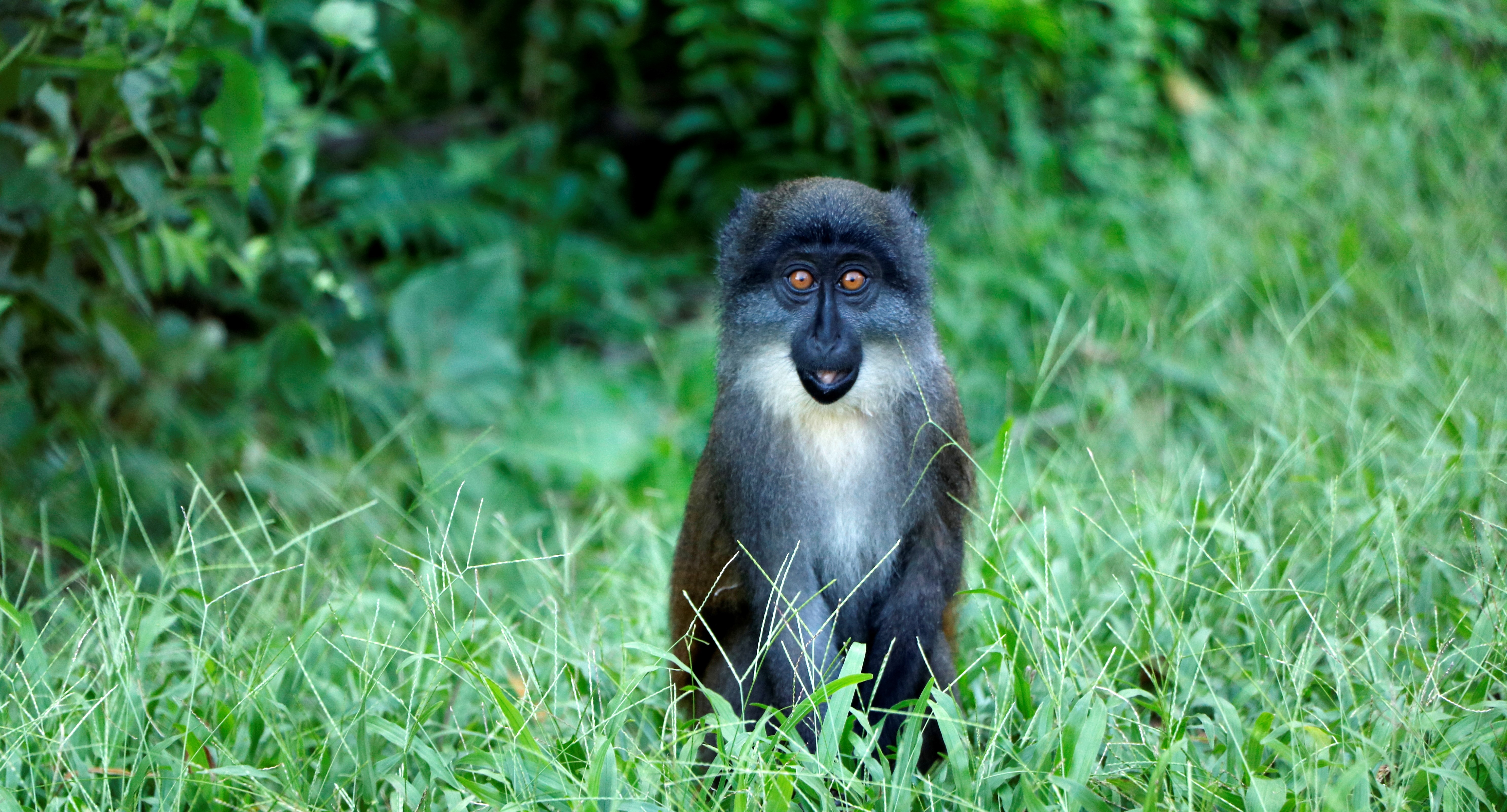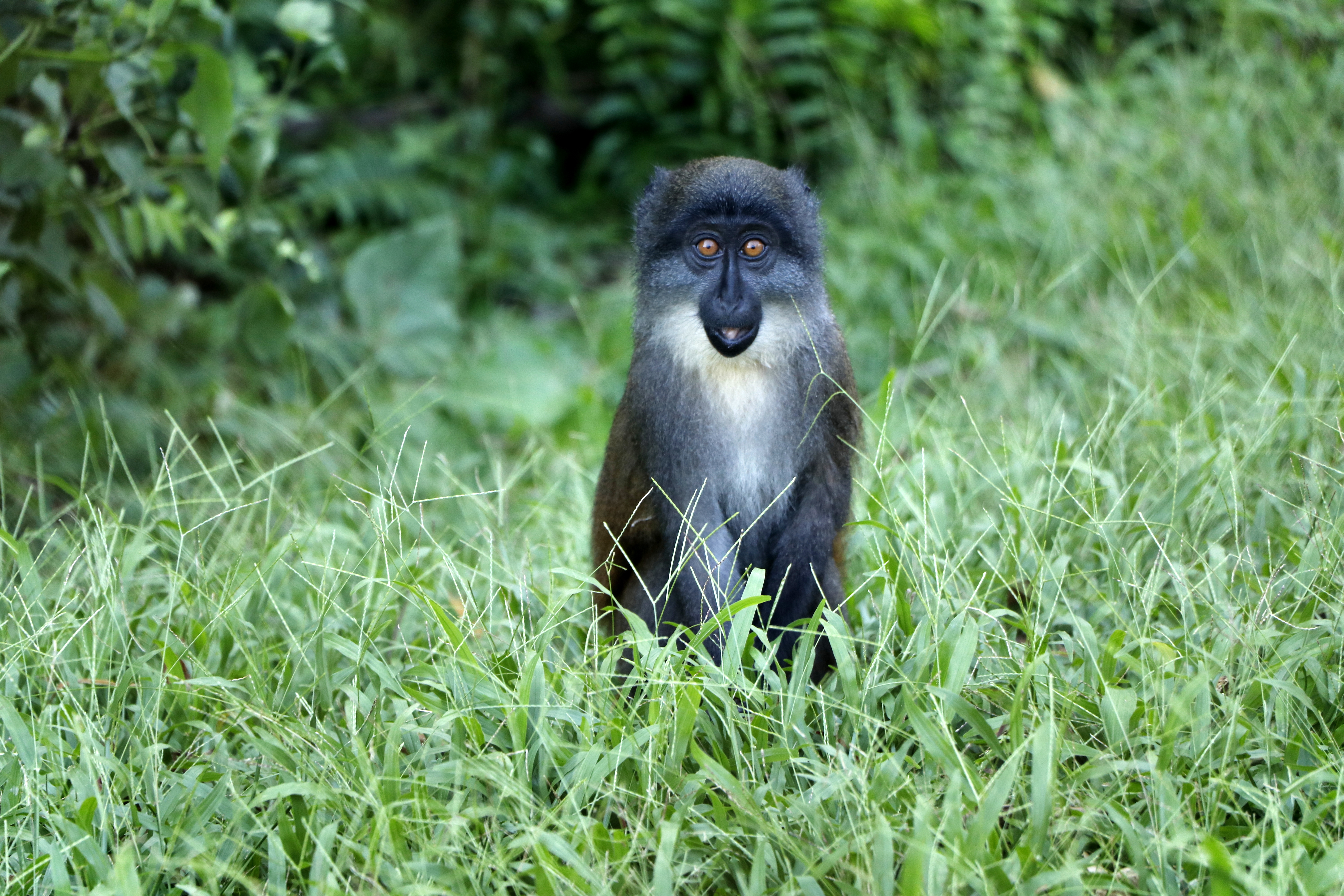


Living near or within the rainforests of Southern Cameroon, humans inhabit vibrant eco-systems. They share their environment with diverse fauna, including vulnerable and endangered non-human primates such as chimpanzees, gorillas, and a variety of small monkeys. Some groups, including the Baka and Bakola people, have preserved a traditional, semi-nomadic lifestyle of hunting and gathering, and are experts on the plants and animals living in their surroundings. This indigenous knowledge is crucial to the outbreak prevention of several diseases, and especially for Ebola virus.
EBO-SURSY_Gabon 2018_CIRMF
Figure 1 A sun-tailed monkey in Gabon Franceville © OIE /S. Muset
The chain of disease surveillance starts with the community
People living in close contact with different animal species are often the first to notice any strange behaviour in their animal neighbours, or the first to discover an unusual number of animal carcasses. These communities, near or within protected areas, are the first link in a chain of surveillance for many animal diseases for this reason. Raising their awareness on the tell-tale signs of animal diseases, and on their role in early warning systems for Ebola virus and other viral haemorrhagic fevers outbreaks, is at the heart of the EBO-SURSY Project. Without the help of the community, animal disease outbreaks can go completely unnoticed, especially in isolated rainforests. Veterinarians remain rare in some countries, and their primary mission is often more associated with livestock and other domestic animals. In parallel, wildlife authorities, while in charge of wildlife conservation, are not always equipped to address animal health issues. A closer collaboration between the two sectors is therefore needed, with efforts by both to build better partnerships with local communities who are familiar with the wildlife ecosystems around them.
Spotting a disease outbreak in animals early on is important for all of us. Many diseases are zoonotic, meaning they can pass from animal to human or human to animal. An outbreak of Ebola virus in gorillas, for example, may be considered as an advanced epidemic warning signal for other species, including humans. If gorilla carcasses are seen frequently in a forest, it may indicate an ongoing outbreak of Ebola, and therefore signal a possible near-future spillover into the human population. These wildlife surveillance systems are not a new idea, but they can work well. They have had success in alerting human health authorities to an imminent Ebola outbreak in the past, including twice in the early 2000s when an estimated 5,000 great apes carcasses were found on the border region of Northern Gabon and Republic of Congo.
For this reason, human-animal interactions continue to play a vital role in the health and safety of humans, as well as the other animals with which they share their environment and resources. To better understand this crucial interface, the EBO-SURSY Project, sensitises communities to the role they can play in wildlife surveillance, and organises research to further study how humans and animals are interacting and therefore exchanging pathogens.
Figure 2 Two Cameroonian children walk to school through forested area
Studying the animal-human interface
The EPVO (Oncogenic Virus Epidemiology and Pathophysiology) Unit at Institut Pasteur, a strategic research partner of the project, works with various local populations groups in Cameroon to better understand the dynamic of pathogen exchange. By identifying the interactions between animals and humans that pose the highest risk of zoonosis transmission, communities can learn how to avoid them, and prevent pathogen spread in the human population. Earlier research by Institut Pasteur teams has previously shown that a severe monkey bite, especially from a gorilla, is a major risk factor for human T-lymphotropic virus (HTLV-1) infection. HTLV-1 affects at least 5 to 10 million people worldwide and can lead to severe diseases, such as adult T-cell leukaemia or lymphoma for which there is no satisfactory treatment. Indigenous and Bantu hunters with severe monkey bites were six times more likely to contract HTLV-1 infections than unbitten hunters living in the same rainforests.
The specific contact of a monkey bite results in an exchange of bodily fluids, such as blood or saliva, which can facilitate the transmission of viruses. Many monkeys and other non-human primates in the region host a similar virus, the simian-T-lymphotropic virus (STLV), and it is presumed that STLV jumped into humans from a similar contact and evolved into HTLV which is now transmissible between humans.
Figure 3 People living near or within protected areas share their surroundings with wildlife (Cameroon)
This discovery has opened the door to how other diseases might be transmissible through bites. As a part of the EBO-SURSY Project, the Institut Pasteur is now working with communities who live at this human-animal interface in Cameroon to perform serological testing for other diseases, including Ebola. By sampling people with high-risk contact with non-human primates, scientists are screening for antibodies to different strains of Ebola virus. The future results of this research will hopefully shed some light on the zoonotic transmission mechanisms of Ebola virus from animals to humans, which has thus far eluded scientists.
While this project aims to provide a better understanding of Ebola spillover, the EBO-SURSY Project’s local activities are actively helping to sensitise local communities on the risks of zoonotic transmission. Thereby contributing to the prevention of future human outbreaks of Ebola and other zoonotic diseases, and making the rainforests a safer place for all primates.
READ MORE: visit the EBO-SURSY Project website
[1] With the financial support of the European Union, the OIE-led EBO-SURSY project implemented in coordination with CIRAD, IRD and the Institut Pasteur, aims to reinforce the capacity of national Veterinary Services in ten West and Central African countries to monitor and respond to the Ebola virus as well as four other haemorrhagic fevers – Marburg virus disease, Rift Valley Fever, Crimean-Congo haemorrhagic fever, and Lassa fever. These five illnesses are zoonoses or diseases that can spread from animals to humans.



